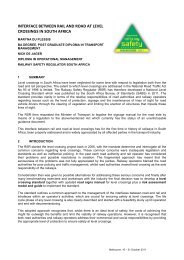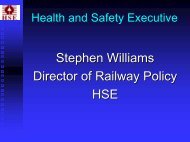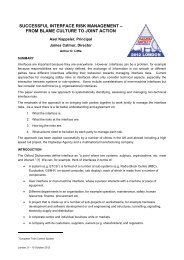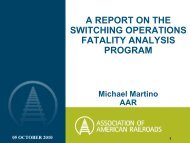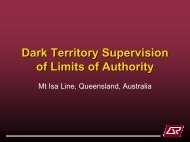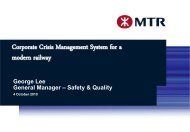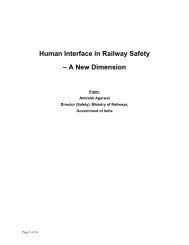Presentation - International Rail Safety Conference
Presentation - International Rail Safety Conference
Presentation - International Rail Safety Conference
You also want an ePaper? Increase the reach of your titles
YUMPU automatically turns print PDFs into web optimized ePapers that Google loves.
Organisation and Cultural Impacts<br />
25th – 27th October 2004<br />
IRSC 2004, Perth, Australia<br />
ENSURING SECURE CROSS-BORDER<br />
OPERATION WITHOUT COMPROMISING<br />
SAFETY<br />
Johnny Restrup-Sørensen<br />
Director Of Infrastructure<br />
Øresundsbro Konsortiet<br />
Denmark & Sweden
Øresund fixed Link alignment
The Øresund bridge
Tunnel portal
Tunnel cross section
Bridge cross section
Two countries – two technologies<br />
Main differences between Swedish and Danish systems:<br />
• <strong>Safety</strong> regulations<br />
• Signaling<br />
• Automatic train protection<br />
• Catenary's voltage and frequency<br />
• <strong>Rail</strong> inclination<br />
• Train radio systems<br />
Other problems:<br />
• Different languages
<strong>Rail</strong>way language<br />
Long term:<br />
Short term:<br />
<strong>International</strong> railway language<br />
Danish & Swedish<br />
Important words: Swedish in Sweden and vice versa<br />
Simple words: Danish or Swedish<br />
Words to be pronounced distinctly and close to the<br />
way they are spelled<br />
Codes will be used e.g. To identify modes of operation<br />
of traction power
Cross-border train operation, the language<br />
Klart för<br />
avgång<br />
Færdigmelding<br />
“Ready for departure”
Signaling aspects<br />
Differences between Danish and Swedish signaling systems<br />
Denmark Sweden Norway<br />
Stop Stop Stop<br />
Proceed and expect Proceed with Drive from/to<br />
Stop at next signal high speed divergent track<br />
(low speed)<br />
Proceed and expect Proceed with Drive from/to<br />
1 green at next signal max. 40 km/h main track<br />
(high speed)
Two countries – two technologies<br />
System border<br />
Changes in one “point” (on the artificial island):<br />
• Signaling<br />
• Traffic management<br />
• Regulations<br />
• Radio system<br />
• Automatic train protection<br />
• Remote control of catenaries system
Interlocking Systems on the Fixed Link<br />
Concentrators<br />
DSB 1990<br />
Relay interface<br />
STLV85<br />
Danish Coast<br />
Peberholm<br />
Swedish Coast<br />
System border
Operating experience<br />
• Overall safety target met in full<br />
• No accidents or potentially dangerous situations<br />
• 81 incidents in 2001 versus 70 in 2002 and 71 in 2003<br />
‣ errors relating to rolling stock, e.g. trains with an<br />
erroneous intercommunication system or faulty<br />
mobile ATP-equipment<br />
‣ incorrect or inadequate safety reports between<br />
Danish and Swedish remote control centres or<br />
between the remote control centre and engine<br />
drivers<br />
‣ infrastructure errors, primarily signalling errors
The Øresund <strong>Safety</strong> Management System<br />
• Senior management commitment<br />
• <strong>Safety</strong> culture, policy & safety goals<br />
• <strong>Safety</strong> information<br />
• Hazard identification and risk management<br />
• Establishing a safety reporting system<br />
• <strong>Safety</strong> assessment/audit<br />
• Accident and incident reporting and investigation<br />
• Recurrent training
The basic safety process
Hazard identification techniques<br />
• Preliminary Hazard Analysis (PHA)<br />
• Failure Mode and Effect Analysis (FMEA)<br />
• Failure Mode Effect and Criticality Analysis (FMECA)<br />
• Hazard and Operability Studies (HAZOP)<br />
• Risk Screening (Hazid sessions)
The four Ps of safety management<br />
Philosophy:<br />
Recognizing that there will always be threats to safety;<br />
setting the organization’s standards; and confirming that safety is<br />
everyone’s responsibility<br />
Policy:<br />
Clear statements of responsibility, authority, and accountability;<br />
development of organizational processes and structures to<br />
incorporate safety goals into every aspect of the operation; and<br />
development of the skills and knowledge necessary to do the job
Procedures:<br />
Clear direction to all staff; means for planning, organizing,<br />
and controlling; and means for monitoring and assessing<br />
safety status and processes<br />
Practices:<br />
Following well designed, effective procedures; avoiding the<br />
shortcuts that can detract from safety; and taking appropriate<br />
action when a safety concern is identified
Human factors in Cross-border operation<br />
Variations in<br />
• Language, communications, culture and social conditions<br />
• Training, selection and assessment of competence<br />
• Infrastructure technology and systems<br />
• Rules, procedures and standards<br />
• Information environment<br />
• Geographical/topographical conditions
Cross-border safety rules and standards<br />
Danish legislation<br />
Banestyrelsens norms & rules<br />
Swedish legislation<br />
Banverkets norms & rules<br />
Area 3 Area 2<br />
Area 1<br />
Danish legislation<br />
and Danish traffic<br />
management<br />
Danish legislation<br />
and Swedish traffic<br />
management<br />
Swedish legislation<br />
and Swedish traffic<br />
management<br />
Ownership<br />
Border<br />
System<br />
Border<br />
Territorial<br />
Border<br />
Ownership<br />
Border<br />
Kastrup Peperholm Lernacken<br />
Supplementary, more rigorous and deviating rules
Radio Systems<br />
Train radio systems<br />
Sweden:<br />
Denmark:<br />
GSM-R<br />
MSR-3<br />
Radio coverage<br />
GSM-R on the entire link<br />
MSR-3 in the tunnel and on the artificial island
Measures introduced so far to support<br />
interoperability<br />
• Documentation of the Infrastructure in Danish,<br />
Swedish and English versions<br />
• Infrastructure Register with reference to the TSIs<br />
• Simplification of rules and procedures<br />
• Developing an “Access Guide” for new and<br />
potential new operators<br />
• Harmonising Health and <strong>Safety</strong> requirement to<br />
<strong>Rail</strong>way personal in Denmark, Sweden and<br />
Norway
Future measures to support<br />
interoperability<br />
• Abandon all-national rules that prevents new or<br />
potential new operators on the Øresund Fixed<br />
Link<br />
• Working for common safety targets, methods<br />
and indicators<br />
• Harmonising the Danish and Swedish rules<br />
and norms related to cross-border traffic<br />
• Seeking influence through NIM (Nordic<br />
Infrastructure Managers)
Lessons learned<br />
1. possible to create a framework for efficient and safe crossborder<br />
rail traffic between Denmark and Sweden<br />
2. Extensive training in safety regulations and competence<br />
development in Danish and Swedish language and culture<br />
have very likely eliminated possible misunderstandings<br />
3. The hazard identification and risk management processes<br />
provide the information needed to control risk at<br />
acceptable levels<br />
4. The final report for the HUSARE project “Managing the<br />
Human Factor in Multicultural and Multilingual <strong>Rail</strong><br />
Environments” has shown to be an useful tool
Thank you for your attention<br />
Johnny Restrup-Sørensen<br />
Jrs@oeresundsbron.com



